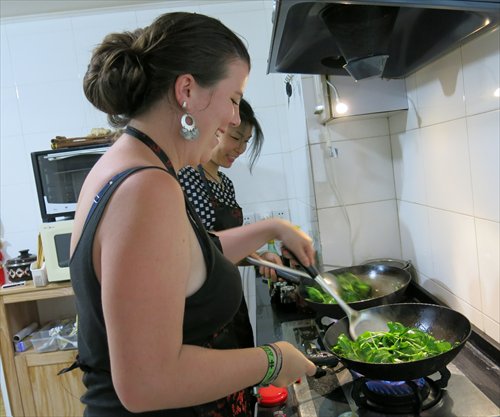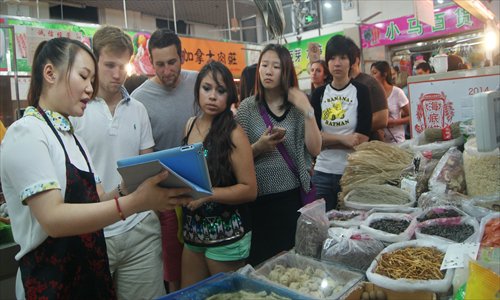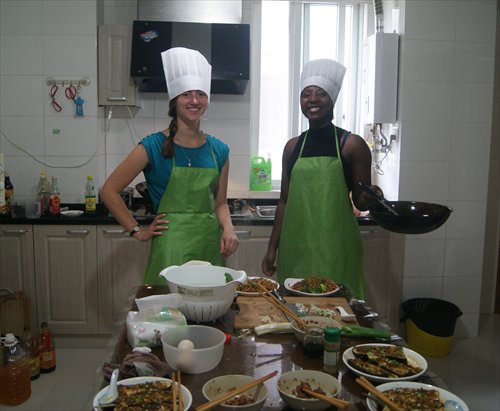HOME >> CHINA, METRO SHANGHAI
Wok this way
By Du Qiongfang Source:Global Times Published: 2014-7-13 18:48:01
Learning to cook Chinese dishes is a must-have experience for foreigners working and studying in China, as the activity serves to convey Chinese culture and provides a window into local people's lives. At the same time, many long-term Shanghai expats have noticed the rising cost of living in recent years. Dining at restaurants isn't as cheap as it used to be. A more economical way to live is to shop at local wet markets and cook Chinese dishes at home, like the locals do.
Cook In Shanghai is a training workshop that gives Chinese cooking lessons in English. The regular group classes and private events organized by the workshop allow their clients to choose which dishes they want to learn to cook.
The cooking training workshop, led by Liu Chaoqun, its co-founder and general manager, also teaches students how to recognize typical Chinese ingredients and bargain at local wet markets.
A private class was given Saturday to French student Camille Perreard, who is doing her PhD in chemistry at Fudan University. Perreard likes spicy food, and kung pao chicken is one of her favorite Chinese dishes. So she chose to learn how to make it, along with two other dishes - garlic sprouts fried with pork and stir-fried water spinach, at her second cooking class at the workshop.
Before class started, Perreard was led by Abby Bu, an assistant from the workshop, to a nearby wet market to shop for ingredients. By visiting the local market, the students can learn how to distinguish the good ingredients from the bad, and practice bargaining in Putonghua. The ingredients for kung pao chicken are chicken breast, dry roasted peanuts and eggs. They also bought garlic sprouts, pork, water spinach and garlic for the other two dishes. "We don't have garlic sprouts in France. I tasted the vegetable before and it is delicious. But this is the first time I will cook with it myself," Perreard said.
While shopping, the assistant showed the students how to tell different vegetables apart and taught them some phrases for shopping and bargaining with vendors. An hour later, Perreard and Bu returned with the ingredients, which Liu washed and prepped.
The workshop's classes can accommodate six people at a time. "We work with different chefs to demonstrate cooking methods based on the recipes the clients want to learn. The chefs can handle six students at a time, all of whom get hands-on experience in our small kitchen," said Liu, who decided to teach Perreard herself.
To cook kung pao chicken, Liu first cut the washed chicken breast into small pieces. Then she mixed salt, chicken essence, sugar, yellow cooking wine, cornstarch, water and egg whites to marinate the chicken in. The second step was to fry the peanuts. Then they deep-fried the chicken in a pan for about three minutes until it turned white. For the last step, Liu added a little chili oil, chili paste, red chili pickled ginger, garlic and green onion into the pan, plus a little water, dark soy sauce, sugar, white pepper, vinegar and wine, which she stir-fried evenly. Then she added the chicken and used the cornstarch to thicken the broth. Finally, she poured in the chili oil, sesame oil and peanuts to complete the dish.
As Liu was cooking, Perreard mirrored each step. She found cutting the chicken to be the hardest part. "The Chinese cooking knife is so big, it is difficult to control," Perreard said.
Compared with kung pao chicken, the steps for cooking garlic sprouts fried with pork was easier. First, clean the garlic sprouts and cut them into segments. Slice the meat, and then marinate it in salt, cooking wine and chicken essence. Then, put oil in the pan and fry the meat for about 30 seconds. After that, put oil in the pan, and fry the garlic sprouts until they get soft. Add the meat, chicken essence, salt and dark soy sauce, and stir-fry the mixture evenly.
The simplest dish of the three was the stir-fried water spinach. The water spinach was fried in oil with garlic for about 30 seconds. Salt and chicken essence were added, and then the ingredients were stir-fried evenly.
The students usually master the Chinese recipes by following the chefs step-by-step. The teachers also prepare written recipes and cooking instructions for the students to practice after class.
When the dishes are ready, there is always a party for the participants and the workshop's staff to enjoy the homemade dishes. "I like spicy food, but not too much, because sometimes it can be very spicy here," Perreard said.



Cook In Shanghai is a training workshop that gives Chinese cooking lessons in English. The regular group classes and private events organized by the workshop allow their clients to choose which dishes they want to learn to cook.
The cooking training workshop, led by Liu Chaoqun, its co-founder and general manager, also teaches students how to recognize typical Chinese ingredients and bargain at local wet markets.
A private class was given Saturday to French student Camille Perreard, who is doing her PhD in chemistry at Fudan University. Perreard likes spicy food, and kung pao chicken is one of her favorite Chinese dishes. So she chose to learn how to make it, along with two other dishes - garlic sprouts fried with pork and stir-fried water spinach, at her second cooking class at the workshop.
Before class started, Perreard was led by Abby Bu, an assistant from the workshop, to a nearby wet market to shop for ingredients. By visiting the local market, the students can learn how to distinguish the good ingredients from the bad, and practice bargaining in Putonghua. The ingredients for kung pao chicken are chicken breast, dry roasted peanuts and eggs. They also bought garlic sprouts, pork, water spinach and garlic for the other two dishes. "We don't have garlic sprouts in France. I tasted the vegetable before and it is delicious. But this is the first time I will cook with it myself," Perreard said.
While shopping, the assistant showed the students how to tell different vegetables apart and taught them some phrases for shopping and bargaining with vendors. An hour later, Perreard and Bu returned with the ingredients, which Liu washed and prepped.
The workshop's classes can accommodate six people at a time. "We work with different chefs to demonstrate cooking methods based on the recipes the clients want to learn. The chefs can handle six students at a time, all of whom get hands-on experience in our small kitchen," said Liu, who decided to teach Perreard herself.
To cook kung pao chicken, Liu first cut the washed chicken breast into small pieces. Then she mixed salt, chicken essence, sugar, yellow cooking wine, cornstarch, water and egg whites to marinate the chicken in. The second step was to fry the peanuts. Then they deep-fried the chicken in a pan for about three minutes until it turned white. For the last step, Liu added a little chili oil, chili paste, red chili pickled ginger, garlic and green onion into the pan, plus a little water, dark soy sauce, sugar, white pepper, vinegar and wine, which she stir-fried evenly. Then she added the chicken and used the cornstarch to thicken the broth. Finally, she poured in the chili oil, sesame oil and peanuts to complete the dish.
As Liu was cooking, Perreard mirrored each step. She found cutting the chicken to be the hardest part. "The Chinese cooking knife is so big, it is difficult to control," Perreard said.
Compared with kung pao chicken, the steps for cooking garlic sprouts fried with pork was easier. First, clean the garlic sprouts and cut them into segments. Slice the meat, and then marinate it in salt, cooking wine and chicken essence. Then, put oil in the pan and fry the meat for about 30 seconds. After that, put oil in the pan, and fry the garlic sprouts until they get soft. Add the meat, chicken essence, salt and dark soy sauce, and stir-fry the mixture evenly.
The simplest dish of the three was the stir-fried water spinach. The water spinach was fried in oil with garlic for about 30 seconds. Salt and chicken essence were added, and then the ingredients were stir-fried evenly.
The students usually master the Chinese recipes by following the chefs step-by-step. The teachers also prepare written recipes and cooking instructions for the students to practice after class.
When the dishes are ready, there is always a party for the participants and the workshop's staff to enjoy the homemade dishes. "I like spicy food, but not too much, because sometimes it can be very spicy here," Perreard said.

French student Camille Perreard cooks stir-fried water spinach Saturday.
Photo: Du Qiongfang/GT

Students visit a local vegetable market to learn about different ingredients used in Chinese dishes.

Foreign students learn to cook Chinese food at a class organized by Cook In Shanghai, a local training workshop.
Photos: Courtesy of Cook In Shanghai
Posted in: Society, Metro Shanghai